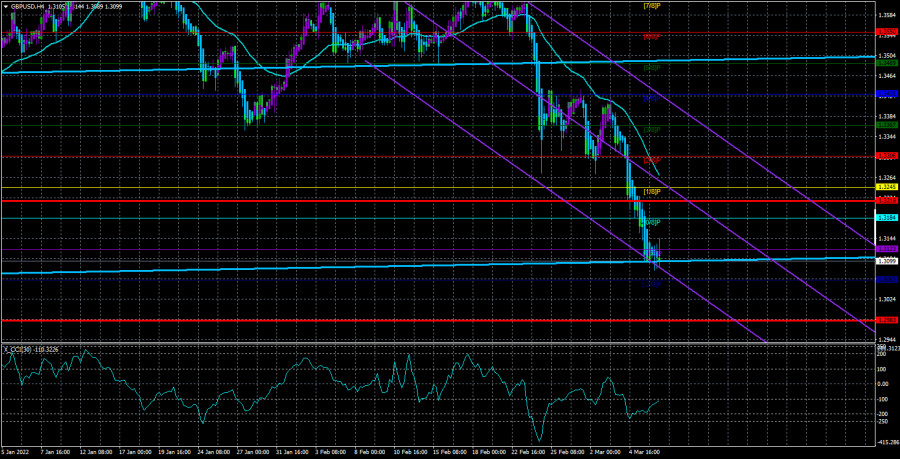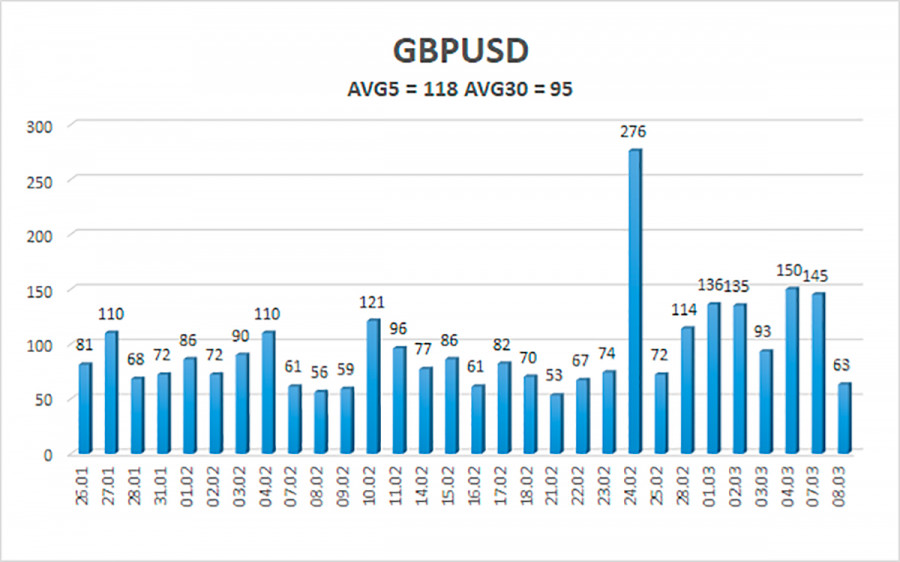

The GBP/USD currency pair did not even pause on Tuesday and just continued its decline from the very night. To be honest, it is even strange now to see such a strong fall in the British currency, since in the last year it was the pound that opposed the dollar most confidently. But in the last few days, the British currency has been in free fall and it is very difficult to associate this fall with anything other than geopolitics. It turns out that both European currencies are now in free fall, just one is falling a little faster, the second is a little slower. From our point of view, this is explained by the currency in which capital is withdrawn from Russia, Belarus (which has also collected quite a large number of sanctions), and Ukraine. Logically, the demand for the dollar is the highest. Perhaps the demand for the euro has now slightly increased, but not for the pound. But all this, unfortunately, is only guesswork. The fact remains that the difficult geopolitical situation in Europe continues to put serious pressure on all risky assets. Stock markets are falling, inflation will rise, and the most risky investment instruments are declining.
From a technical point of view, everything is bad for the pound right now. The pair could not stay above the 38.2% Fibonacci level on the 24-hour timeframe, could not update its previous local maximum, could not confidently overcome the Kijun-sen and Senkou Span B lines on the same daily TF. But it was able to break through its previous local minimum and now it may well continue to fall in the medium term to the important Fibonacci level of 50.0% - 1.2827. On the 4-hour TF, all indicators indicate a downward trend, and we don't even really see corrections. The Heiken Ashi indicator has been directed only downwards for several days in a row. Thus, today there is no reason to expect that the trend will change.
The West will refuse Russian oil.
Meanwhile, British Prime Minister Boris Johnson said that no matter how much the EU countries want to abandon Russian oil and gas, it cannot be done overnight. He noted that many EU countries are almost 100% dependent on supplies from Russia, and Bulgaria has already announced that it will require an exception for itself since it simply has nothing to replace Russian hydrocarbons with. However, this does not solve the problem of exporting carbohydrates from Russia for Russia itself. It lies in the fact that the demand for oil and gas from the Russian Federation will still fall. Every day we witness that more and more new oil and fuel companies refuse to buy in the Russian Federation. Yesterday, for example, Shell left the Russian market. Thus, it may turn out that there is oil, but the demand for it will decrease so much that Moscow will have to make serious discounts to simply sell off the entire volume. As we have already said, oil production cannot be suspended or put on pause. Moreover, at the moment, oil from Russia is still being supplied at the old prices, and new contracts for future supplies are being signed with a creak, in particular, due to sanctions imposed by the West on Russian banks.
At the same time, the US Congress openly stated that today President Joe Biden could announce an oil embargo for Russian oil. The share of Russian oil exports to the United States is not too large, but in the current conditions, it is still a strong, additional blow to the Russian economy, which has already been isolated from the whole world and under the yoke of a huge number of sanctions. Experts estimate that the Russian Federation has overtaken even North Korea in terms of the number of sanctions. Taking into account these changes, the process of global redistribution and redirection of capital will continue on world markets. And this means that the current year will be very nervous and a crisis for everyone. Experts are already talking about a new economic crisis and a global recession. In general, "out of the fire and into the flames." We had just survived the COVID epidemic when the war began in the very center of Europe.

The average volatility of the GBP/USD pair is currently 118 points per day. For the pound/dollar pair, this value is "high". On Wednesday, March 9, thus, we expect movement inside the channel, limited by the levels of 1.2983 and 1.3218. A reversal of the Heiken Ashi indicator upwards will signal a round of corrective movement.
Nearest support levels:
S1 – 1.3062
Nearest resistance levels:
R1 – 1.3123
R2 – 1.3184
R3 – 1.3245
Trading recommendations:
The GBP/USD pair continues its strong southward movement on the 4-hour timeframe. Thus, at this time, you should stay in sell orders with targets of 1.3062 and 1.2983 until the Heiken Ashi indicator turns up. It will be possible to consider long positions no earlier than fixing the price above the moving average with targets of 1.3306 and 1.3367.
Explanations to the illustrations:
Linear regression channels - help to determine the current trend. If both are directed in the same direction, then the trend is strong now.
Moving average line (settings 20.0, smoothed) - determines the short-term trend and the direction in which to trade now.
Murray levels - target levels for movements and corrections.
Volatility levels (red lines) - the likely price channel in which the pair will spend the next day, based on current volatility indicators.
CCI indicator - its entry into the oversold area (below -250) or into the overbought area (above +250) means that a trend reversal in the opposite direction is approaching.